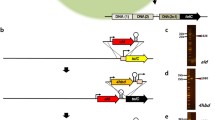Abstract
We used the plasmid BLUR-8 that contains an 800-base pair (bp) sequence of human repetitiveAlu DNA in a cotransfection protocol to target the plasmids pSV2neo or EBO-pcD-leu-2 (hygro) into a single site of the sole human chromosome, number 11, of a Chinese hamster-human hybrid cell line (AL). The neo and hygro plasmids confer resistance to antibiotics G418 and hygromycin, respectively. Of the 33 cotransfected clones with single-site insertions, 1/13 without BLUR-8 and 6/20 with BLUR-8 were only in human chromosome 11. A frequency of insertion of 1/13 is not different than expected by chance (ϱ=0.3512). On the other hand, the probability that 6/20 insertions, as seen with BLUR-8, occurred by chance is low (ϱ=0.0003). We suggest that the human DNA sequences contained in BLUR-8 targeted insertions into only the human chromosome.
Similar content being viewed by others
Literature cited
Waldren, C., Jones, C., and Puck, T.T. (1979).Proc. Natl. Acad. Sci. U.S.A. 761358–1362.
Waldren, C., Correll, L., Sognier, M.A., and Puck, T.T. (1986).Proc. Natl. Acad. Sci. U.S.A. 834839–4843.
Waldren, C.A. (1983). Mutational Analysis in Cultured Human-Hamster Hybrid Cells. InChemical Mutagens: Principles and Methods for Their Detection, Vol. 8, (ed.) de Serres, F.J. (Plenum Publishing, New York), pp. 235–260.
Glaser, T., Housman, D., Lewis, W.H., Gerhard, D., and Jones, C. (1989).Somat. Cell Mol. Genet. 15477–501.
Kao, F.T., Jones, C., and Puck, T.T. (1976).Proc. Natl. Acad. Sci. U.S.A. 73193–197.
Jones, C., Bill, J., Larizza, L., Pym, B., Goodfellow, P., and Tunnacliffe, A. (1984).Somat. Cell Mol. Genet. 10423–428.
Kao, F.-T., Jones, C., and Puck, T.T. (1977).Somat. Cell Genet. 3421–429.
Waldren, C., Martin, J., Sutherland, J., and Cram, S. (1984).Cytometry 5584–588.
Thomas, K.R., and Capecchi, M.R. (1986).Nature 32434–38.
Adair, G.M., Nairn, R.S., Wilson, J.H., Scheerer, J.B., and Brotherman, K.A. (1990).Somat. Cell Mol. Genet. 16437–441.
Jessberger, R., and Berg, P. (1991).Mol. Cell Biol. 11445–457.
O'Gorman, S., Fox, D.T., and Wahl, G.M. (1991).Science 2511351–1355.
Littman, D.R., Thomas, Y., Maddon, P.J., Chess, L., and Axel, R. (1985).Cell 40237–246.
Pellicer, A., Robins, D., Wold, B., Sweet, R., Jackson, J., Lowy, I., Roberts, J.M., Sim, G.K., Silverstein, S., and Axel, R. (1980).Science 2091414–1421.
Thomas, K.R., and Capecchi, M.R. (1987).Cell 51503–512.
Ham, R.G. (1965).Proc. Natl. Acad. Sci. U.S.A. 53288–293.
Southern, E.M. (1975).J. Mol. Biol. 98503–517.
Sambrook, J., Fritsch, E.F., and Maniatis, T. (1980).Molecular Cloning: A Laboratory Manual, 2nd ed., (Cold Spring Harbor Laboratory Press, Cold Spring Harbor, New York).
Roth, D., and Wilson, J. (1988). Illegitimate recombination in mammalian cells. InGenetic Recombination, (ed.) Kuchlerpati, R., and Smith, G.R. (American Society of Microbiology), pp. 621–653.
Jasin, M., Elledge, S.J., Davis, R.W., and Berg, P. (1990).Genes Dev. 4157–166.
Ayares, D., Chekuri, L., Song, K.-Y., and Kucherlapati, R. (1986).Proc. Natl. Acad. Sci. U.S.A. 835199–5203.
Sedivy, J.M., and Sharp, P.A. (1989).Proc. Natl. Acad. Sci. U.S.A. 86227–231.
Lin, F.W., Sperle, K., and Sternberg, N. (1984).Mol. Cell Biol. 41020–1034.
Jasin, M., and Berg, P. (1988).Genes Dev. 21353–1363.
Wong, E.A., and Capecchi, M.R. (1986).Somat. Cell Mol. Genet. 1263–72.
Song, K.-Y., Chekuri, L., Rauth, S., Ehrlich, S., and Kucherlapati, R. (1985).Mol. Cell Biol. 53331–3335.
Kucherlapati, R. (1985).Mol. Cell Biol. 53331–3336.
Darby, V., and Blattner, F. (1984).Science 2265646–5650.
Nickoloff, J.A., and Reynolds, R.J. (1990).Mol. Cell Biol. 104837–4845.
Mishina, Y., Ayusawa, D., Seno, T., and Koyama, H. (1991).Mutat. Res. 246215–220.
LeDoux, S.P., Thangada, M., Bohr, V.A., and Wilson, G.L. (1991).Cancer Res. 51775–779.
Capecchi, M.R. (1989).Science 2441288–1292.
Rossant, J. (1990).Neuron 2323–334.
Kucherlapati, R.S. (1989).Prog. Nucleic Acid Res. Mol. Biol. 36301–310.
Saxon, P.J., Srivatsan, E.S., Leipzig, V.G., Sameshima, J.H., and Stanbridge, E.J. (1985).Mol. Cell Biol. 5140–146.
Ege, T., Krondahl, V., and Ringertz, N.R. (1974).Exp. Cell Res. 88428–432.
Schor, S.L., Johnson, R.T., and Mullinger, A.M. (1975).J. Cell Sci. 191–23.
Beyer, W.H. (1986).Handbook of Tables for Probability and Statistics, (The Chemical Rubber Co., Cleveland, Ohio).
Author information
Authors and Affiliations
Rights and permissions
About this article
Cite this article
Waldren, C., Braaton, M., Vannais, D. et al. The use of human repetitive DNA to target selectable markers into only the human chromosome of a human-hamster hybrid cell line (AL). Somat Cell Mol Genet 18, 417–422 (1992). https://doi.org/10.1007/BF01233081
Received:
Revised:
Issue Date:
DOI: https://doi.org/10.1007/BF01233081




